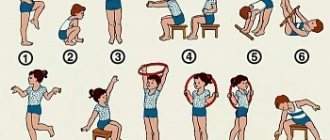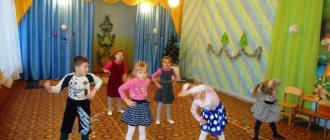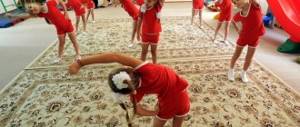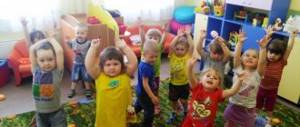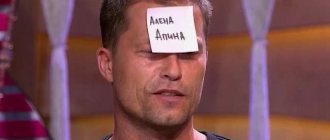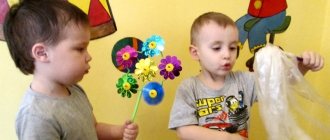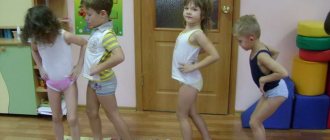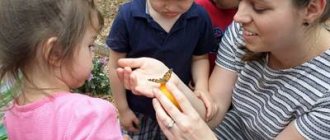Morning exercises for children in preschool educational institutions
Morning exercises are not just a few exercises, it is a whole complex specially selected for all muscles. Moreover, it is important not only to finally wake up the child, but also to give children the opportunity to carry out a common task in a team. Such communication helps to reduce the internal tension that involuntarily takes over the child after the parents leave and he is left without them for the whole day.
Goals
The goals of morning exercises can be considered:
- organizing children’s communication during physical activity;
- relieving the child’s nervous tension and putting him in a positive mood;
- instilling discipline.
Tasks
The teacher and physical education instructor have the following tasks:
- adjust the child’s body to active work;
- repeat material already covered, in this case exercises;
- gain new knowledge, in this case, learn new movements that help stimulate all organs;
- give the concept of discipline, consolidate the ability to work in a team.
Types of morning exercises
There are several types of morning exercises. The following are suitable for preschoolers:
Game view
In this case, children participate in various games, and each game is aimed at performing specific movements. Games can be fast and not too active. At the end of the gymnastics, breathing exercises are required. Instead of traditional games, a relay race with an obstacle course may be offered. In addition to exercises, children can also be offered jogging; preschoolers like this type of physical activity, and it is also very good for health.
Rhythmics
This gymnastics, as a rule, is performed to energetic music, which itself already charges with good energy. Children run, jump, do dance moves, and do exercises to get all their muscles working. This type of gymnastics is carried out for older preschoolers; they already know how to work well in a team and are more disciplined.
With visual aids
Preschoolers are invited to complete a set of exercises, which are drawn on special cards. Such work is impossible in younger groups. Only older preschoolers can navigate and complete the exercise schematically depicted on the plate.
Methodology for morning exercises in kindergarten
Morning exercises for children in kindergarten. The load during gymnastics increases gradually, the peak of activity is in the middle of the gymnastics, and at the end of the complex the activity decreases.
Exercises are carried out in close mode. A minimum of time is spent on explaining how to do it. Sports equipment is also distributed very quickly.
Each movement is repeated several times, and the load increases through repetition.
There are several methods of doing gymnastics. Practical exercises include exercises that are already known to children and have been repeated many times in class. There may also be exercises with some changes in technique. Playful and competitive forms are encouraged. Among the verbal methods, it is worth mentioning the following: performing exercises by name, by its description, with an explanation of the exercise. In addition, verbal methods include commands, conversations, and the question-answer form. The third section is visual methods. These include demonstration of exercises, various manuals that depict exercise diagrams. Musical, audio and visual cues are used.
Principles of gymnastic complexes
Morning exercises in kindergartens for preschool children were compiled by specialists. Complexes in children's educational institutions are carried out according to the principles:
- Accessibility: tasks and games correspond to the physical training of students, explanations and demonstrations of exercises are clear.
- Effectiveness and benefits: gymnastics develops preschoolers and improves their health.
- Positive: preschoolers do UG for a great mood; if the child is not inclined to exercise (sick, upset), he should not be forced to do the exercises.
Physical education of a young child
For gymnastics to become a habit among preschoolers, it must interest them and evoke only positive emotions. To ensure students’ persistent motivation for classes, the teacher must choose interesting exercises, conduct them in the form of a game, or use original equipment.
Exercise demonstration
Stages of morning exercises
Morning exercises for children in kindergarten. Gymnastics for preschoolers can be divided into three stages.
- First, preparatory
Children need to be set up to perform a set of exercises; the child’s body must prepare for physical activity. It is important to understand that the main goal is to improve the child’s health, prevent flat feet, and develop correct posture. The increase in physical activity is gradual. The initial stage of gymnastics is formation, exercises in formation. This can be various turns, walking on toes, heels, normal, with raising the knees, jumping, running.
- Second stage, main
This stage includes exercises for muscle activity, and also includes exercises that shape posture. General developmental exercises for the neck, shoulder girdle, torso, abs, arms, legs are the most basic in this stage. Exercises are performed standing, on the floor, sitting. Pair exercises are practiced. The exercises can also be performed in threes.
- Third stage, final
After physical activity, the body should gradually calm down, the heart rate should be equalized, and breathing should also be evened out. Therefore, after active exercises, walking and breathing exercises will be useful. Preschoolers love round dances, which are both a playful element and at the same time a stabilizing activity.
It is worth noting that morning exercises are performed by preschoolers in their groups. The teacher needs to teach children to correctly follow commands, be active, and disciplined. It is important for the teacher to find the right tempo for the exercises, select the right musical accompaniment, if required, pay attention to the correctness of the children’s exercises and immediately correct mistakes. After all, if the child does not perform the exercise as required, then there will be no sense in such physical activity.
Structure and methodology of morning exercises in all age groups of preschool educational institutions
Lyudmila Geller
Structure and methodology of morning exercises in all age groups of preschool educational institutions
Structure and methodology of morning exercises in all age groups of preschool educational institutions
Content
Introduction 2
Building morning exercises 3
Morning exercises with children of the third year of life 4
Morning exercises for children of the fourth year of life 6
Morning exercises with children of the fifth year of life 7
Morning exercises with children of the sixth and seventh year of life 10
Conclusion 12
References 14
Introduction
In preschool institutions of the usual type, morning exercises are carried out daily before breakfast, in kindergartens with round-the-clock attendance of children - immediately after a night’s sleep (exercises)
.
Morning exercises are included in the regime from the first junior group . It is aimed mainly at solving health problems. Contributing to the strengthening of the musculoskeletal system, the development of the cardiovascular, respiratory, and nervous systems, it at the same time creates a cheerful, cheerful mood and fosters the habit of daily physical exercise. The combination of morning exercises with water procedures is very useful for hardening a child’s body.
Exercise, which is carried out immediately after a night's sleep, helps to “wake up”
child, strengthen the activity
of all organs and systems and start the day in an organized manner in a preschool institution.
In the process of morning gymnastics , other physical tasks are solved to one degree or another (formation of correct posture, development of physical qualities, mental moral, aesthetic and labor education.
Building morning exercises
It begins with drill exercises. This is followed by different types of walking, alternating with running, which enhance breathing and blood circulation. After walking and running, children are reorganized to perform general developmental exercises. They are followed by jumping and more intense running. Morning exercises end with walking with different hand positions. At the end, children can read poems in chorus that emphasize the importance of morning exercises , or sing a marching song (standing still or while walking)
Morning exercises with children of the third year of life
Directions to the organization. For the first time, morning exercises are included in the daily routine in the first junior group . It is carried out every day at the beginning of the year with all the pupils of the group at the same time . Its duration is up to 5 minutes.
Morning exercises at this age , in addition to the main task, provides an organized start to the day in kindergarten and makes it possible to switch children’s attention to joint forms of activity.
Considering that many children of the third year of life do not immediately join in the activities organized by the teacher and lag behind in completing tasks, the teacher should take a very subtle and differentiated approach to individual children, and not insist on the indispensable participation of everyone in morning exercises .
Content. The content of gymnastics is 3-4 general developmental exercises, walking, running and jumping. Gymnastics begins with short walking, alternating with slow running for 20 - 30 seconds, and forming a group . Forming in a circle is most convenient at this . At the beginning of the year, it is better to use a scattered formation, since children are still poorly oriented and it takes too much time to organize a formation into a certain form.
The introductory and final walking can be done in a group in a certain direction or in pairs, holding hands, scattered or behind each other. Walking should be calm and leisurely. Having lined up, children begin to perform exercises to strengthen the muscles of the shoulder girdle and arms, legs, back, abdomen and entire torso.
General developmental exercises are selected from those recommended for classes. Almost all of them are imitative in nature and are carried out in a playful way . During morning exercises, sitting, lying on your back and on your stomach positions are widely used. In the second half of the year, small objects can be used for general developmental exercises: rattles, flags, cubes.
The number of repetitions of each exercise is 4–5 times, it depends on the nature of the movements, their complexity and the preparedness of the children.
Then running , a fun outdoor game or jumping on the spot (2 times for 15 - 20 seconds with a short pause for rest)
.
Morning exercises end with calm walking in place or moving forward to reduce the general excitement of the body.
A complex is made up of the exercises in the above sequence, which is performed without significant changes for 2 weeks in a row.
Each new complex is usually performed somewhat slower at first, since children do not immediately remember the exercises and the teacher has to spend a lot of time explaining and demonstrating them. Therefore, at first you can repeat some exercises only 3–4 times, and at a slower pace. Once children have mastered all the exercises, they should be done at a good, energetic pace. After some time (2 – 3 months)
It is advisable to return to repeating the same complex or take it as a basis for compiling a complex for exercises with objects.
The teacher makes certain demands on the quality of children's movements. Makes sure that the child, if possible, occupies the required starting position, and ensures that the children’s movements are at least basically similar to the model.
For example, the methodology for conducting the morning exercise complex “Cockerel and Hen”
will be like this: pictures with the image of a cockerel and a hen are first examined, the teacher talks about them.
Then, when performing the complex, the teacher portrays a cockerel, the children - hens. During morning exercises, the teacher makes sure that the children do not hold their breath.
Morning exercises for children of the fourth year of life
Directions to the organization. The organization of morning exercises in the second junior group is essentially no different from its organization in the first junior group . If at the beginning of the year it is possible to allow some of the children not to take part in morning exercises , then after 1.5 - 2 months everyone should do it. It is necessary to gradually accustom children to join in it without unnecessary reminders from the teacher. Increases the duration of morning exercises (5 - 6 minutes)
.
Content. Complexes of morning exercises are made up of 4 – 5 exercises of a general developmental nature. Walking, jumping in place, and running must be included in the content.
At the beginning of morning exercises, short-term walking is given in different ways (with a change of direction, on tiptoes, etc.)
Walking can be done in any formation: one after another, scattered, in pairs without holding hands. It alternates with running.
Then the children stand in a circle or sit in a free formation to perform general developmental exercises. In the first half of the year, mainly exercises learned by children last year are used. This promotes their repetition and consolidation, and gives the opportunity for children newly admitted to the group to catch up to the general level. Exercises are also used to strengthen the muscles of the shoulder girdle, arms, and legs. Back, abdomen and entire torso recommended in the exercise section. These exercises are most often based on figurative imitation. General developmental exercises with cubes, flags, rings, and medium-sized balls are common. The sequence of exercises is the same. The most common starting positions are standing, sitting, lying on your back and on your stomach. Repeat exercises in this age group 5 – 6 times . It depends on the complexity and nature of the exercises, the preparedness and emotional state of the children. In conclusion, you should run, jump on the spot (2 times in 10 - 15 seconds with a short rest)
or an active game, well known to children, with very simple rules and content.
The complex of morning exercises without any special changes is repeated for 1 - 2 weeks in a row.
Leadership techniques. When performing morning exercises, it is important to monitor the quality of children’s movements and the clarity of the recorded poses. By ensuring that the movement is similar to the model in general terms, the teacher ensures that it is performed in the specified manner. As in the previous group , exercises in morning gymnastics are based on the actions of characters known to children ( “Bees”
,
“Bear Cubs”
, etc.).
Throughout the gymnastics, the teacher acts together with the children, showing and explaining the exercises and the correct ways of movement.
However, the teacher does not complete the exercises with the children. Having done it 2-3 times and setting the pace of execution, he continues to conduct the exercise verbally, while simultaneously observing the actions of the children, making the necessary instructions along the way. By the middle and especially by the end of the year, it becomes possible to use exercises that are not tied to a coherent plot.
While doing the exercises, the teacher reminds the children when it is more appropriate to inhale and exhale, and makes sure that the children do not hold their breath while walking and running.
Morning exercises with children of the fifth year of life
Directions to the organization. When conducting morning exercises indoors , it is recommended to organize it not in a group room , but in a hall. Children of the fifth year of life are more independent in preparing for and participating in morning exercises . Its duration is 6 – 8 minutes.
Content. The content of morning exercises includes exercises in walking, running, jumping in place and 4 - 5 exercises to strengthen the muscles of the shoulder girdle and arms, neck, legs, abdomen and back. The structure of morning exercises is the same as in the previous group . Morning exercises begin with a short walk, which should not be monotonous and boring. It is performed in any formation: one after another, in pairs, scattered, etc. Gradually, the walking turns into a light run (1.5 - 2 laps around the hall)
. And running again turns into calm walking, during which a lane change is made.
To perform general developmental exercises at the beginning of the year, children most often stand in a circle. In the second half of the year, formation in links is also used. The arrangement of general developmental exercises in the morning exercise complex is the same as in previous groups : first, exercises for the shoulder girdle and arms, then for the legs and torso. The content of the complexes consists of exercises familiar to children. All possible general starting positions are used (standing, sitting, lying, kneeling)
and different starting positions of the hands
(to the sides, forward, etc.)
.
In addition to small objects , medium-sized cubes, skittles, and balls are used for exercises. Number of repetitions 4 – 6 times. After general developmental exercises jumps are performed on the spot . They become more varied: legs apart - legs together; with turns around; jumping back and forth over a tape lying on the floor; moving forward around the pins. Dosage 15 – 20 jumps (1-2 times)
. They can be replaced by running in place or around the hall, turning into calm walking. Emotional play can be used.
Each complex of morning exercises is repeated for 1 – 2 weeks. Some exercises may vary. Leadership techniques. In the middle group, of morning exercises remains to attract children's attention to collective forms of activity and for an organized start to the day in kindergarten. At the same time, its role in activating the functional activity of the child’s body is increasing For children aged five years, morning exercises are carried out at a good , vigorous pace, without long pauses between exercises.
The peculiarity of the explanation of the exercises is brevity and clarity. The teacher only reminds you of the diagram of the exercise, the sequence of its parts, for example: “put your feet wider, hands on your belt, bend forward. Let's start! One, two, three, straighten up.” And then, as the exercise progresses, without losing the rhythm of the movement, he continues his explanations, putting forward requirements for the correctness of the movement: “Lower, bend lower, look at me, straighten up. Let’s repeat it again,” says the teacher, leaving the group : he noticed that most of the children bend their legs while bending. – Keep your legs straight. One, two, three, lower, straighten up.”
It is necessary to remind and show children when it is convenient to inhale and exhale during exercises, and make sure that they do not hold their breath while running and jumping.
Running and jumping are a mandatory part of all morning exercises . It is these exercises that place the greatest functional and emotional stress on the child’s body. Performed daily in large doses, they lead to a positive training effect. At the beginning of morning exercises, fast running with wide strides is not used. On the contrary, running is done at a moderate pace, in small steps, with the feet planted on the toes, arms freely bent, body straight, looking forward. At the end of morning exercises, running should be active and energetic. During the jumps, the teacher sets a certain pace - approximately 12 - 15 jumps in 10 seconds. The high pace is explained by the fact that children of the fifth year of life do not jump very high in place, only slightly lifting their socks off the floor.
If children are very excited after running and jumping, you need to let them calm down. For this purpose, calm walking in place or some breathing exercises are good (arms to the sides - inhale, lower your arms - exhale; arms down - back - inhale, lower your arms - exhale, the same, rising on your toes, etc.)
The same exercises are sometimes used at the end of morning exercises . But they should not be viewed as mandatory. They are offered by the teacher if necessary. A slight increase in breathing is a reaction to intense movements, there is no need to be afraid of this, the breathing rate quickly returns to normal without additional measures.
Morning exercises with children of the sixth and seventh year of life
Directions to the organization. Morning gymnastics is becoming a familiar form of daily physical education. When preparing for it, children provide great assistance to the teacher: they gather their peers for morning exercises , prepare the necessary equipment, and vacate the premises. The teacher makes sure that the children do not detain each other by talking. last 8-10 minutes .
Content. Walking exercises should be varied. Walking is widely used with changes in pace, direction, on the toes, heels, outer sides of the foot, raising the knees high, “goose bump”
walking, stepping over obstacles, etc., attention exercises. For example, the teacher raises a yellow flag - everyone goes, green - they run, red - they stop; when they clap, they turn around; When the whistle blows, they quickly sit on the floor, and then continue moving, etc.
All these exercises are carried out in different formations. They do not last long and turn into easy running (2 – 3 laps around the hall)
. Running again turns into calm walking. And a rebuild is taking place.
The complex uses 5–6 general developmental exercises. To perform them, it is most convenient to build in links. In the links, the children open up so as not to interfere with each other. A checkerboard formation is used, when the links take a step forward after one another. For the convenience of performing exercises while sitting and lying down, it is advisable to turn all children half a turn to the right or left.
Among the various starting positions in the second half of the year, the main stance (heels together, toes apart) morning exercises.
. As before, the starting positions for the hands are very different.
During morning exercises in the senior group, the volume of general developmental exercises without objects . Exercises with gymnastic sticks , hoops, and jump ropes are included. Each exercise is repeated 5–6 times. Jumping in place with different combinations of movements of the arms and legs, moving forward and backward, jumping over tall , etc. repeated 20–30 times (1 or 2 times with a short break)
.
As in other groups , one set of morning exercises is carried out for 1 – 2 weeks . At his own discretion, the teacher can make clarifications and changes to it. Leadership techniques. The main feature of morning exercises in older groups is the responsible attitude of children to its implementation. For them, it is not necessary that it be entertaining and figurative. The teacher explains to the children the purpose of morning exercises , reveals its role in physical development, the acquisition of strength, agility, the formation of a good physique, a beautiful gait, etc.
During morning exercises , the teacher requires accuracy in the positions and directions of movement of body parts, and the ability to perform the exercise in accordance with the count or tempo of the musical accompaniment .
The quality of general developmental exercises is quite high. The teacher begins to teach children to stretch their legs, arms, fingers, pull their toes, stand, sit or lie in a given relaxed, but at the same time somewhat tense and taut pose. Children like to perform movements well and beautifully.
Since morning exercises use exercises known to children, their explanation has some specificity - it should be very clear and brief, in fact only reminding children of the starting position, the type of movement (bending, squatting, etc., and the requirements for its quality.
Explanations of the exercise are combined with demonstration only in the first days of mastering the complex. Moreover, the teacher widely involves children who have good command of movement in the demonstration.
Children of senior preschool age quickly remember the sequence of exercises in complexes. They successfully do them without the accompanying example of a teacher . As a last resort, they focus on the children in front or nearby. This allows the teacher not to be in front of the group , but to walk between the rows of children, carefully observe each person’s exercise, and provide individual assistance. It is important not to lose track of the pace and rhythm of the counting that regulates the children’s joint actions.
Throughout the morning exercises , the teacher repeatedly draws attention to the children’s posture, reminding them of the need not to hold their breath, to breathe deeply, to coordinate inhalation and exhalation with the most appropriate phases of movement (arms to the sides - inhale, arms down - exhale, etc. )
. Some exercises involve slight natural straining. At the moment of such straining, there is a short breath holding while inhaling, then successive inhalation and exhalation.
The instructions for running and jumping are the same as in the middle group .
Conclusion
Morning exercises in a preschool institution are an important component of the motor regime. It provides a good mood and increases vitality. Morning exercises involve the child’s entire body in an active state, deepen breathing, increase blood circulation, promote metabolism, raise emotional tone, cultivate attention, determination, evoke positive emotions and joyful sensations, increase the vital activity of the body, and provide a high healing effect. Children who systematically engage in morning exercises lose their drowsiness, feel more alert, and improve their performance.
Daily morning exercises at a certain time in a hygienic environment, properly selected sets of physical exercises, disinhibit the nervous system of children after sleep, activate the activity of all internal organs and systems , increase physiological metabolic processes, increase the excitability of the cerebral cortex, as well as the reactivity of the entire central nervous system . The flow of impulses going to the brain from all receptors - visual, auditory, musculoskeletal, skin - increases the vital activity of the body as a whole.
In addition to its health benefits, morning exercises also have great educational value. Its systematic implementation instills in children the habit of doing physical exercise every day, teaches them to start their work day in an organized manner, act in a coordinated manner in a team, be purposeful, attentive, self-controlled, and also evokes positive emotions and a joyful feeling. In addition, daily performance of certain sets of physical exercises helps improve motor abilities in children, develops physical qualities (strength, agility, flexibility, improves the functioning of coordination mechanisms, and contributes to the acquisition of knowledge in the field of physical education.
Thus, morning exercises are an integral organizing moment in the daily routine of a preschool institution and an important component of physical education and health work with preschoolers.
Bibliography
1. Kozhukhova N. N., Ryzhkova L. A., Samodurova M. M. Physical education teacher in preschool institutions. –M: Publishing
, 2002. – P. 91 – 94.
2. Keneman A.V., Khukhlaeva D.V. Theory and methods of physical education of preschool children - M. , “Enlightenment”
, 1972. pp. 203 – 208.
3. Osokina T.I. Physical education in kindergarten: a manual for children’s teachers. garden – M., “Enlightenment”
, 1986.
4. Tarasova Z.I. Physical education classes in a kindergarten group of different ages : a manual for preschool teachers. – Mn., 2000.
5. Khukhlaeva D.V. Theory and methods of physical education of preschool children . Ed. 2nd, revised and additional – M., “Enlightenment”
,1976.
Recommendations for gymnastics for children of different ages
Morning exercises for children in kindergarten. Gymnastics is different for children of different ages. First of all, because young children are still getting used to discipline, it is difficult for them to immediately grasp and carry out the teacher’s command. So, younger preschoolers do not form a column. Running in a “flock” is mandatory here. Running takes no more than 15 seconds. Children also do exercises not in a column, they stand in a circle. For younger preschoolers, a set of 4 general developmental exercises should be developed. The teacher performs all exercises together with the students.
Preschoolers from middle groups have their own rules. They perform gymnastics in a column. Running takes no more than 20 seconds. General strengthening exercises are performed when children line up in two lines. The set of such exercises should include no more than 5 tasks. The teacher explains how to do the exercises. Each exercise is named so that children can remember the name. While the children are doing exercises, the teacher looks for mistakes and helps correct them.
For older preschoolers, the complex of general developmental exercises consists of 6 tasks; for children from the preparatory group, the complex can contain no more than 8 exercises. The run lasts 30 seconds. During gymnastics, the teacher just needs to name the exercise so that the children understand which one they should perform. Often a team of little athletes has a “soloist”; this is a child who is at the head and performs all the exercises as required. Other children watch him as they do their exercises. This way you can avoid mistakes in the exercise technique. During gymnastics, the teacher is in the group and monitors the correct execution of the exercises and helps those children who make mistakes.
The selection of sports equipment for preschoolers is important. Younger preschoolers work with flags, cubes, and rattles. Children from middle groups also use flags, cubes, as well as ribbons and strings during gymnastics. Older preschoolers already know how to handle a hoop, gymnastic stick, skipping rope, and ball.
Exercises in kindergarten as part of the general educational process
Kindergarten pupils must grow up healthy so that they develop the required skills and abilities, as well as abilities. A healthy baby is well trained, understands what the teacher wants from him, and is interested in learning new things. Exercise, which is a systematic activity in kindergarten, helps with this.
Charging at a preschool educational institution
Its goal is to preserve and strengthen the psyche and the body as a whole. The main task is to create a positive emotional mood. Morning exercises (MG) are an integral part of the physical training regime for preschool children. This is a set of special exercises for muscle tissue and joints.
Exercises for preschoolers can be carried out as part of activities that have a positive effect on the respiratory system and games for fine motor skills. UG can take place together with the hardening technique. In addition to health-saving functions, exercise in a preschool educational institution is important for the formation of mental processes, broadening one’s horizons, and communication skills.
Important! During ultrasonography, endorphin, the hormone of happiness, is actively produced. It improves mood and protects against negative thoughts.
A boost of energy from performing gymnastic exercises
Goals and objectives of the UG
Gymnastics in preschool educational institutions is divided by age groups: 2-3 years, 3-4 years, 4-5 years, 5-6 years, 6-7 years. The physical component is important for the entire period of education. The purpose of exercise in kindergarten is to instill a desire to monitor your health throughout your life.
Every day the morning in kindergarten begins with a training session, which makes it possible to strengthen the little body.
For your information! It is important to instill in a person a love of physical education from childhood; in kindergarten they lay the foundation for the future. The goal of UG is to improve the functioning of body systems.
Exercise has enormous health-improving and educational significance. Many preschool teachers find it difficult to create a set of activities that will be more effective for children of different ages, and they use the recommendations of the Federal State Educational Standard.
Every morning in most kindergartens in Russia begins with UG. The purpose of exercise is to develop body muscles and improve health conditions. The baby’s body needs physical exercise, it needs to release energy. It can be directed in the most useful direction by involving preschoolers in active and interesting exercises and exciting games.
Exercise is important in organizing the day and for the well-being of the students. Those who are already awake and starting to pamper will become calmer with the help of exercises. Sleepy and inactive guys, on the contrary, will cheer up. The purpose of exercise is to normalize discipline. You should exercise daily so that your baby gets used to organized sports. Then it will not cause negative emotions and fatigue, but, on the contrary, will turn into pleasure.
For your information! It is important to choose sets of exercises according to the age and capabilities of preschoolers.
Topics for morning exercises in preschool educational institutions
For preschoolers, regular exercises are not interesting. We need an exciting topic. In order for gymnastics to bring pleasure and bring a good mood, and also to consolidate the knowledge already acquired by the preschooler in thematic and creative classes, teachers come up with topics.
For example:
- A trip to the garden.
- Autumn Walk.
- Insects.
- Forest inhabitants.
- Winter walk.
- Smart pedestrian.
- On the ship.
- Fire brigade.
- Sea adventure (visiting the little mermaid).
There can be many options; each complex has exercises with characteristic names: “Sailors”, “Algae”, Sleeping Bear”, “Squirrel with Nuts” and others. It is interesting for children to perform such play exercises; ordinary gymnastics turns into an interesting game.
Duration of morning exercises for children by age
For each age, there are time limits for performing gymnastics. Younger preschoolers do exercises for no more than 6 minutes, children in middle groups - from 6 to 8 minutes, children from the older group do gymnastics for no more than 10 minutes, in the preparatory group the time allotted for exercises is from 10 to 12 minutes.
Graphic dictations for preschoolers by cell
Methods for doing exercises in kindergarten
Carrying out an educational session is a responsible process, since the work involves children. Exercises for children in preschool educational institutions should be performed either by a physical instructor in the gym, or directly by a teacher directly in the group. According to the rules, UG is carried out half an hour before the first meal.
Hoop exercise
Duration recommendations
UG in each kindergarten group differs not only in duration, but also in the nature of certain exercises. Recommendations:
- The duration of the lesson in the younger group of kindergarten should not be more than 5 minutes. To make it interesting for students, exercises should take place in the form of a game with jokes and jokes. For example, kids can be asked to walk like a bear, a fox or a horse. Hula hoops, cubes and maracas are suitable for performing exercises.
- In the middle kindergarten group, the training course lasts 6 minutes. The structure of the exercise is a little more complicated than the previous one; you can add ribbons and balls as objects for exercise.
- Pupils in the senior group of kindergarten have excellent memory, so the GC can be carried out without the participation of a teacher. The teacher only has to show them how to practice once. Recommended equipment includes pigtail cords, balls, hoops and sticks. The complex can include dancing and rhythm. Lesson duration is approximately 10 minutes.
- The training session in the preparatory group of the kindergarten lasts 12 minutes and, by and large, repeats the complex of the senior group. The equipment used is jumping ropes and dumbbells. In addition, some sports elements using a wall bars can be added to the complex.
How to organize children for morning exercises
In addition to the game theme, the teacher can use other techniques to attract children to the UG. Expressive language, engaging content and positivity will help motivate students. You can play it so that they want to exercise on their own, become healthier and stronger.
An original approach will help motivate you to do morning exercises at a preschool educational institution. For example, a teacher can invite all the children to visit Winnie the Pooh, and to get there, you need to jump three times and smile. This element of the game will attract the children, and they will definitely fulfill all the conditions.
At preschool age, all children are very inquisitive. They are interested in how animals move, flowers grow and what is happening on the planet. Experienced teachers use this to organize effective exercises. They come up with a lot of playful exercises for children to exercise in the morning with the connection of characters and fictional characters.
Complex of morning exercises for the first junior group
Important! If a child has a certificate stating that physical activity is temporarily contraindicated for him (these are issued after an illness), you can offer him to be the presenter or observe the process from the bench.
